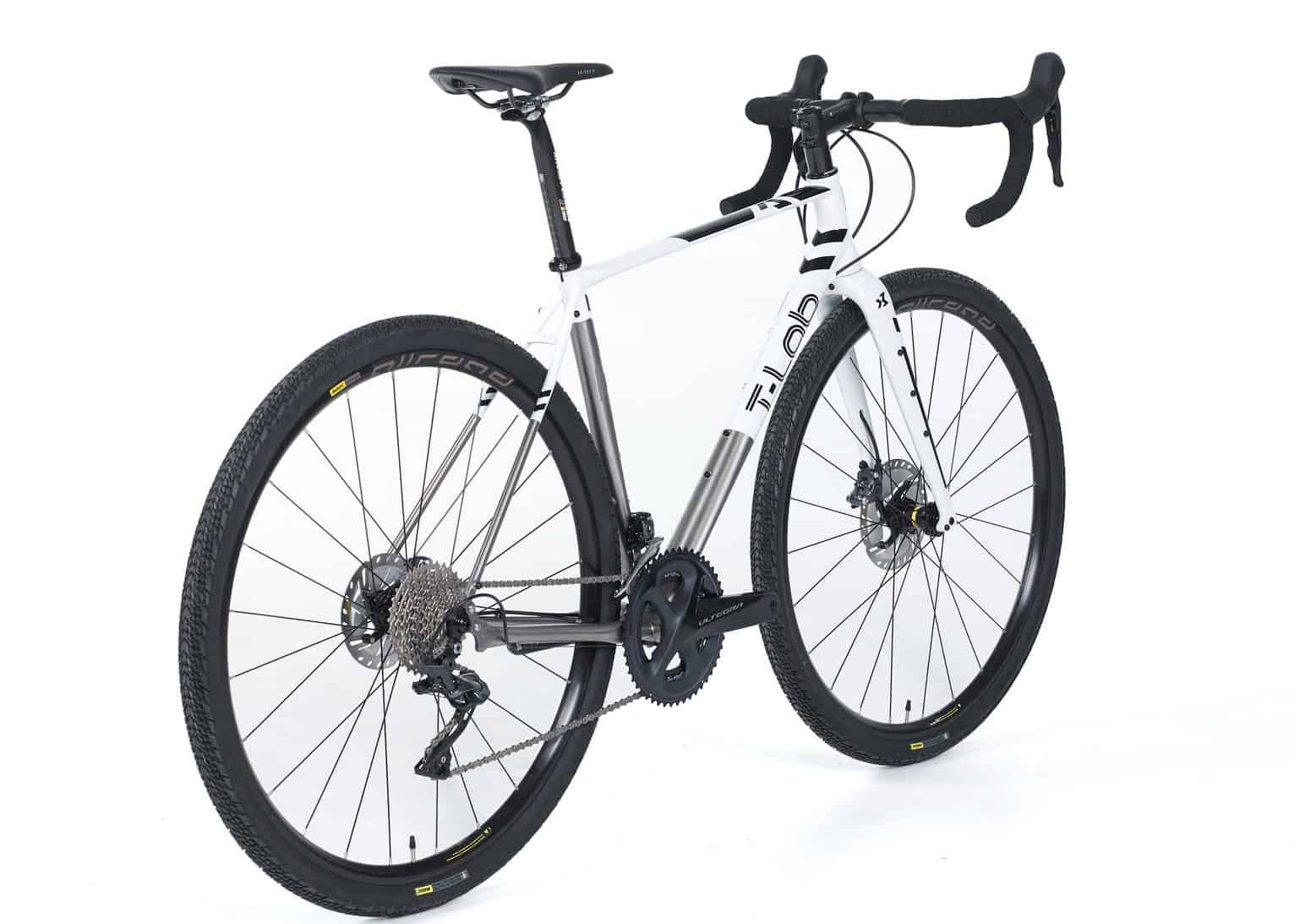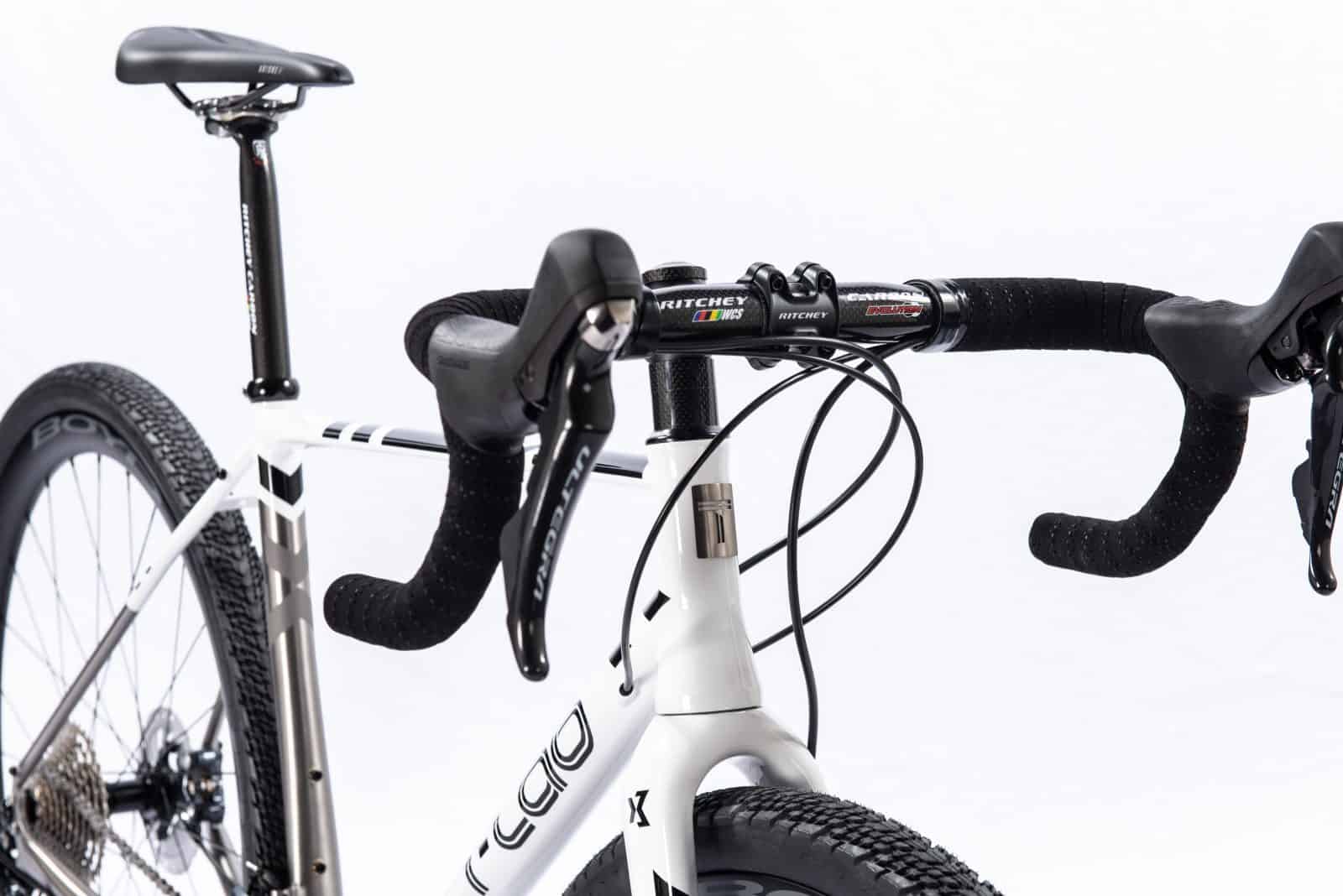In a world of the carbon, where you can shape the tubes however you want, steel and titanium seem to be living in the past with their traditional rounded tubes. But T-Lab, Canadian titanium bike maker believes that it does not have to be that way. I spoke with Rob, T-Lab co-founder, about their unique, modern approach to titanium and what are the benefits of those flattened tubes in a titanium bike.

CyclingAbout: What is the idea behind T-Lab? What kind of bikes do you intend to make?
Rob: The driving notion behind T-Lab is to make next-generation titanium bikes. What we mean by that is to push titanium past its craftsman heritage in order to make bikes that correspond to the performance standards and stylistic preferences of today’s cyclists. Ultimately, if you want to go faster, and longer, T-Lab is the bike for you.
CyclingAbout: Why titanium bikes? What is so special about titanium in your opinion?
Rob: We consider titanium to be the noblest of bike building materials, one which possesses an exceptional combination of qualities when worked properly: Strength-to-weight, fatigue resistance, pliancy, and overall durability. The characteristic that needed to be improved with regards to titanium is ‘stiffness-to-weight’, a key contributor to cycling performance. More specifically, lateral rigidity is essential for power transfer and is ideally maximized while minimizing overall frame weight. In the past, titanium bikes were somewhat limited with regard to lateral stiffness as compared to top carbon fibre models. With the T-Lab’s Ti-Morph shaping technology, the days of relatively “flexy” round tube Ti bikes are now behind us. Now, titanium has absolutely nothing to envy of any other material when it comes to cycling performance.
CyclingAbout: The single most unique thing about your X3 bike is the tubing. A lot of flattened tubes. Can you explain the purpose/benefit of this kind of tubing on a titanium frame?
Rob: Our unique titanium shaping capability produces an exceptionally profiled titanium frame that delivers 30% more lateral stiffness and related performance versus leading round-tube Ti frames. Essentially, at various key areas on the frame, we take a round cross-section with isotropic characteristics and create a sort of anisotropic cross-section to enhance strength and stiffness exactly where it’s needed. The result is the utmost optimization of cycling performance, from top to bottom on the frame.
CyclingAbout: Does this special tubing impacts the durability of the frame and makes it more fragile and prone to cracks?
Rob: The seamless, Grade 9 (3Al – 2.5v) titanium we use is cold-worked to optimize stiffness-to-weight without affecting the inherent ride quality and toughness of Ti. Creating the radical shapes on our frame without heating and thus negatively affecting the intrinsic qualities and durability of titanium is a technological achievement that took us a lot of time and trial and error to get to. It results, in our estimation, in the most advanced titanium bike in the game right now.
CyclingAbout: What is the weight of the frame, for example, size small?
Rob: All our bikes are made-to-order, so they vary depending on the cyclist’s specifications. That said, a frame in our signature size small would weigh-in in the 1200-gram range.
CyclingAbout: It is said that with carbon you have the freedom to create a frame that is stiff where needed and offers a lot of compliance in places where you want. With titanium, you either make a compliant frame or a stiff one. Is this true also with your approach to titanium or with all of those specially shaped tubes you managed to combine the stiffness and compliance?
Rob: An exceptional bike, one that distinguishes itself from the countless options out there, is a bike that demands no compromise from the cyclist, one that delivers on all levels. That is what we strive to achieve with every T-Lab we make. As such, the driving force underlying our Ti shaping technology is to maximize lateral stiffness and the related power transfer where it’s needed, all while optimizing the inherent comfort-enhancing qualities of titanium. Mission accomplished.
CyclingAbout: How comfortable the X3 is compared to other titanium bikes? I know it is 30% stiffer but maybe with the flattened top tube (which is usually done to improve compliance), it is also more comfortable than a regular titanium frame.
Rob: I will go beyond my personal impressions and base myself on what our customers are telling us. Let me read you a recent testimonial we received:
“The X3 is special with regards to comfort. A sample: “I have just completed a ride from Seattle north around the peninsula and then south to San Diego on my new T-Lab X3. I have loved the X3 the entire 1800 miles. No creaks, no problems, and best of all it’s such a comfortable ride.” – Brian Thompson
That’s just an example, but one that typifies the feedback we get from T-Lab owners. Through our unique frame design, we’ve managed to push the performance aspects of titanium while actually enhancing the vertical compliance and comfort its inherent pliancy provides.
CyclingAbout: Usually, a steel or titanium frame looks very similar in terms of construction. Straight stays with a bridge connecting them near the top tube junction and a similar bridge connecting the chainstays near the BB. Your bike looks more like a carbon bike because it does not have a bridge connecting chainstays. Why is that? What is the effect of that frame construction both in terms of stiffness and compliance?
Rob: This is a classic case of forming the following function. The prime design directive, once again, was to maximize lateral stiffness and related performance while maintaining titanium’s inherent ride quality. In essence, our unique titanium shaping capability allows us to simulate what is achieved in a carbon bike design. The difference is that, with titanium, you don’t have to worry about possible failure if you take a bump on the frame or if your airline is not particularly delicate in transporting your bicycle. In essence, we believe we’ve reconciled modern performance with the old-school notion of quality, one based on durability. To that end, a titanium bike will also maintain its resiliency over the long haul, something you can’t say about carbon or even aluminum.
CyclingAbout: My steel bike is very comfortable but at the same time, not very power efficient (due to this flex). How would you evaluate your bike in terms of stiffness compared to steel, titanium, and carbon bikes? My understanding is that a combination of special tubing and a big press-fit BB should create something very similar to a carbon frame, but am I right?
Rob: Exactly. Most T-Lab owners tell us that their bike rides like a carbon bike, one that happens to be bullet-proof. Versus what you describe with your steel bike, a T-Lab bike would compare favorably on the stiffness-to-weight aspect, with no comfort disadvantage and with the added bonus of being corrosion-proof. When all characteristics are considered, we truly believe we’ve created a special bike, one that is all-around in the very best sense of the term.
CyclingAbout: You did not go with a standard threaded BSA (English) bottom bracket? People say that press-fit BB is unreliable and noisy. Should I worry about this with your titanium bike?
Rob: We get this question a lot. It would appear that many cyclists have unfortunately experienced the infamous creaking problem with press-fit bottom brackets, particularly on carbon bikes. It’s not an issue with T-Lab, and we’ve put out hundreds of bikes featuring a press-fit BB. Given the precision of the titanium tubing we use and the way we meticulously post-machine it, we have not had any creaking issues to date. On the flip side, the use of a BB-386 or BB-86 compatible BB shell provides an important advantage with regard to stiffness enhancement.
CyclingAbout: Did you design the fork of the bike by yourself? What kind of fork it is both in terms of stiffness and compliance? The reason I am asking this is that there are a lot of good bikes out there with an overly stiff fork that makes the ride too harsh and I really prise the bikes like Argon 18 Dark Matter which provides both precise steering and a comfy ride. Is this the same case with your fork?
Rob: The 100% carbon fork we use is made for us by a reputable supplier and designed to perfectly marry the characteristics of our T-Lab models. It provides just the right combination of the stiffness, vibration absorption, and consistency needed in that particular section of a bike.
CyclingAbout: Is your bike designed more for 700c or 650b wheels? And what kind of wheels do you use with your personal bike?
Rob: The T-Lab X3 gravel bike, our flagship model, was designed as the ultimate one-quiver bike, and thus works well with both wheel standards (given the disc brake + thru-axle configuration). When you are making high-end bikes that are particularly long-lasting, you want to make them as versatile and future-proof as possible. That said, the majority of the bikes we put out, including mine, use 700c as the base setup.
CyclingAbout: What do you think about the solutions like BMC MTT, Cannondale Kingpin suspension or Specialized FutureShock? In other words, can a titanium frame without moving parts still compete with this kind of solution in terms of comfort?
Rob: Based on the rave reviews we have received, I would say a resounding ‘yes’. No disrespect to what others are putting out, but we’ve spent a lot of time and resources to deliver comfort in a performance-oriented bike frame, based on the principle of unleashing the inherent qualities of titanium. It’s a simple idea, but it wasn’t easy to do.
CyclingAbout: What do you think about the trend of flexing handlebars like Giant D-Fuse or a carbon HollowGram from Cannondale (which is a very flat handlebar with a lot of visible flex)? Can a titanium handlebar compete with that? Do you plan to make one?
Rob: Honestly, I don’t know enough about those particular products to offer a credible opinion. We applaud any innovation as long as it’s functionally based and not gimmickry. That said, for now, we don’t have any plans other than to continuously enhance our titanium frame designs.
CyclingAbout: What gravel trends in general and in terms of comfort do you see emerging or getting stronger in the coming years?
Rob: The gravel bike is here to stay, as it addresses the obvious consumer need for a road-based bicycle that can open up more riding possibilities. The French term, vélo de route tout-terrain, in fact, is probably a better term for the category, as ‘gravel’ seems a little bit reductive a term for some cyclists. The trend towards versatility, when combined with quality and durability, will continue to gain momentum as consumers seek better value for their hard-earned money and more sustainable solutions.
————————————————————————
Roberto Rossi, co-founder of T-Lab, whose mission is to push titanium bikes forward. Before contributing to the advent of the new school Ti, Roberto was Head of Marketing & Communications at Guru Bikes, where he led a complete brand transformation that culminated in Bicycling Magazine’s Dream Bike of The Year and worldwide recognition for this Canadian manufacturing of custom carbon bikes.
Roberto possesses 30 years of multi-disciplinary marketing and communication experience, having successfully managed at all levels of branding. Provided value-added strategic services for the likes of Nike, McDonald’s, and Coca-Cola. He also led the Canadian marketing team for Puma.







